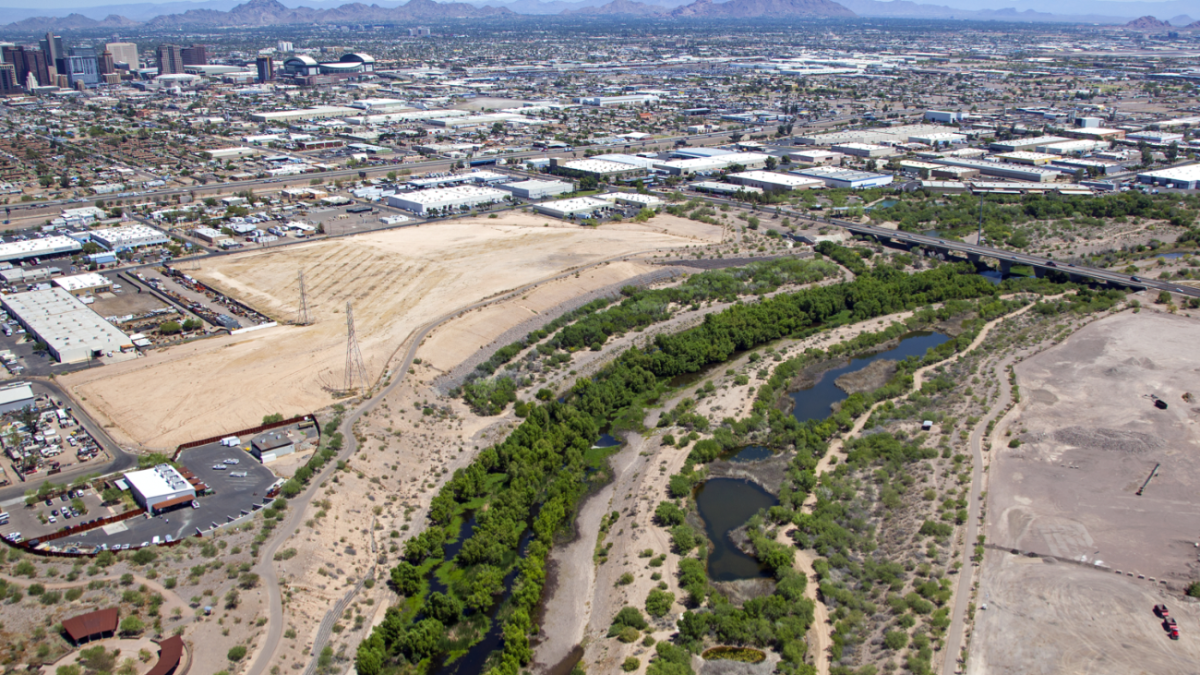Rio Reimagined flows forward with cleanup event and Urban Waters Partnership

Now through June 28, volunteers throughout the metro Phoenix region will be putting on masks and picking up trash as part of a nationwide cleanup event called “Masks On, Litter Gone.”
Arizona State University, on behalf of Rio Reimagined, is partnering with the Ball Corporation and River Network for the cleanup, with the goal of collecting 2,500 pieces of litter throughout the Valley.
Participants — who are encouraged to wear masks and maintain appropriate social distancing during the event — are using technology to assist with the cleanup. Using the app Litterati, volunteers will upload a photo of each item they collect. The app keeps track of their progress and awards a $50 gift card at the end of the week to the challenge leader.
“Through the app Litterati, we can replicate that experience of a community cleanup with a little competition,” said Kylie Cochrane, ASU student and intern at Rio Reimagined. “Individuals can join us from wherever they are, their neighborhood, local park, or trail and individually make a collective impact.”
The two-week cleanup isn’t the only attention Rio Reimagined is receiving lately.
The cities of Phoenix, Tempe and Avondale, in partnership with ASU, recently formed a Rio Reimagined Brownfields Coalition and secured $1.4 million in grant funding from the U.S. Environmental Protection Agency. Rio Reimagined is the initiative to protect, restore and revitalize the Salt and Gila River corridor traversing the metro Phoenix region. The recent effort was the vision of the late U.S. Sen. John McCain, who asked ASU to lead, convene and facilitate the regional effort.
The grants will support the assessment and cleanup of contaminated sites (called brownfields) along the 58-mile stretch of river, priming the space for restoration and possible future development. Eliminating brownfields, many of which are former industrial sites, will enhance the health of the surrounding communities and natural environment, and create new, usable public spaces.
The grants add to a growing number of awards the team has received over the past year and a half in support of Rio Reimagined. Melissa McCann, director at the University City Exchange, leads the regional effort that resulted in the awards.
“We’re building capacity,” McCann said. “Public and private grant funding will support stakeholders’ efforts to transform the health of the river corridor, environmentally, socially and economically.”
The grants come on the heels of Rio Reimagined being invited into the federal Urban Waters Partnership — a designation that brings resources, support and access to funding. Only the 20th project to be recognized in this manner, this is the first project to achieve this standing under the current administration.
“This is only the beginning,” McCann said. “This initiative will require expanded community engagement and direction to fully realize the opportunities available to transform the river into an asset that serves all.”
The EPA funding will allow for two significant projects to take place in the region.
The first grant of $600,000 will support an environmental assessment of the land bordering the Salt, Agua Fria and Gila rivers to identify areas that are viable for redevelopment. Sites in Phoenix, Avondale and Tempe that will be considered for assessment formerly housed dry cleaners, landfills, wastewater treatment plants, dry wells, underground storage tanks and waste tire dumps.
The second grant of $800,000 will go to the city of Phoenix for the cleanup of contaminated sites throughout the city, including along the Rio Salado. The city will work with local grassroots organizations, developers and government agencies to remove hazardous materials like lead-based paint, chemicals, animal waste, trash, mold, asbestos and gasoline.
Cecilia Rivere, assistant director at the University City Exchange, points to regional coordination and past and present leadership from cities and tribal nations as factors in the Rio’s success.
“The sum can be greater than the individual parts,” Rivere said. “If you band together and you approach something from a regional perspective, planning and designing a community asset at scale, there can be larger and better benefits.”
Thinking and acting regionally comes naturally to the staff at the University City Exchange, who view their role as reflective of ASU’s charter to assume fundamental responsibility for the communities it serves.
“The goal of Rio is to improve life in the Valley by enhancing environmental quality, building cultural identity, restoring wildlife habitat and providing an economic catalyst,” said Wellington “Duke” Reiter, special adviser to the president and executive director of the University City Exchange. “It’s an appropriate leadership role for ASU to support communities in this way as reflected in our charter.”
Top photo courtesy of Tim Roberts Photography.
More Environment and sustainability

ASU President Michael Crow named to TIME100 Climate list
Arizona State University President Michael Crow has been named to the 2024 TIME100 Climate list of leaders and innovators driving real climate action.The list includes leaders across a range of…

Driving green desalination
Wilderness survival TV show hosts, pirates and water treatment researchers agree on one thing: Most natural water sources are not safe for drinking. Among the many potential risks is the high salt…

ASU preservation facility serves as test bed for rooftop heat mitigation
A roof coating that uses thermal energy storage materials from Arizona State University spinout EnKoat is halting the heat in several ASU buildings — including a section of the university’s largest…